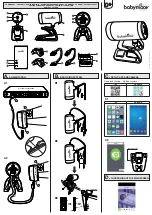
18
EN
ABOUT BLOOD PRESSURE
1. What is blood pressure?
Blood pressure is the force exerted by blood against the walls of the arteries. Systolic pressure occurs when
the heart contracts. Diastolic pressure occurs when the heart expands.
Blood pressure is measured in millimetres of mercury (mmHg). One‘s natural blood pressure is represented
by the fundamental pressure, which is measured first thing in the morning while one is still at rest and before
eating.
2. What is hypertension and how is it controlled?
Hypertension is an abnormally high arterial blood pressure. If this is left unattended it can cause many health
problems including stroke and heart attack.
Hypertension can be controlled by altering lifestyle, avoiding stress and with medication under a doctor‘s
supervision.
To prevent hypertension or to keep it under control:
t
Do not smoke
t
Reduce salt and fat intake
t
Maintain proper weight
t
Exercise regularly
t
Have regular physical checkups
3. Why measure blood pressure at home?
Blood pressure measured at a clinic or doctor‘s office may cause apprehension and produce an elevated
reading, 25 to 30 mmHg higher than the value measured at home.
Home measurement reduces the effects of outside influences on blood
pressure readings, supplements the doctor‘s readings and provides a
more accurate, complete blood pressure history.
4. WHO blood pressure classification
Standards for assessment of high blood pressure, without regard to
age, have been established by the World Health Organization (WHO),
and shown in chart beside.
Reference Material:
Journal of Hypertension 1999, Vol 17 No.2
Diast
o
lic
bl
oo
d
pr
essur
e mmHg
Systolic blood pressure mmHg
Grade 3 hypertension (severe)
Grade 2 hypertension (moderate)
Grade 1 hypertension (mild)
High-normal
Normal
Optimal
Summary of Contents for Wave Professional
Page 1: ......
















































